
| WWT Shows | CLICK TO: Join and Support Internet Horology Club 185™ | IHC185™ Forums |

|
• Check Out Our... • • TWO Book Offer! • |
Welcome Aboard IHC185™  Internet Horology Club 185
Internet Horology Club 185  IHC185™ Discussion Site Main Page
IHC185™ Discussion Site Main Page  Horological Discussions, Questions and Answers
Horological Discussions, Questions and Answers  European Pocket Watch Forum
European Pocket Watch Forum  Fusee question ? (onion case)
Fusee question ? (onion case)
 Internet Horology Club 185
Internet Horology Club 185  IHC185™ Discussion Site Main Page
IHC185™ Discussion Site Main Page  Horological Discussions, Questions and Answers
Horological Discussions, Questions and Answers  European Pocket Watch Forum
European Pocket Watch Forum  Fusee question ? (onion case)
Fusee question ? (onion case)Page 1 2
Go  | New Topic  | Find-Or-Search  | Notify  | Tools  | Reply to Post  |  |
Bernard: Mid 18th century means around 1750! I think thats a good guess for the watch plus or minus 15 years 1735-1765 perhaps. | ||||
|
An interesting discussion. Thank you. I would date Bernhard's watch after about 1720 but before 1730. The balance bridge is very large. By 1730 they had tended to become smaller. But the silver trim around the cirumference of the movement is a feature that became common from about 1720 until the end of the 'oignon' period about 1725. Silver trims often went with silver bridges and silver pillars, though that is on French watches. I don't see anything, othe than the name of Royle itself to tie down the first movement in the discussion to the 1750s or 1760s specifically. I've seen movement like this from 1720 up to 1760s. So the name is key to pinning the date down I think. Best wishes to all Jack | ||||
|
Thank you everybody for a great disussion. I especially appreciate when some one doesn´t just come with a opinion about for exemple a mvt age. To learn something i think it´s great when the opinion is followed up by a motivation to why. But maybe sometimes it can be hard to tell, it´s more of a feeling that years of experience create. Actually, I await information about the Bramer from a watch and clock museum in Amsterdam. I will left that information here if there is any intersting sort of information. Thanks again! Bernhard | ||||
|
Good point Bernhard. So to break down my thoughts.. First I look for hallmarks.. Then a general look at the pocketwatch...i thought the hands and dial were wrong...and possibly the case. Lets start with the hands...see the bend in it..very typical of someone who does not know what they are doing putting hands on..(I know 200+ years anything could have bent them) I think the hands would have been pierced gilt or if the dial was enamel maybe black beetle . Dial.. calender opening just looks wrong and if we want to push this back to 1720's then the minute increments are wrong too. I still feel with that beautiful bridge it would have had a silver dial and the fact that it is a calender watch too reinforces this for me. Without seeing the inside of the cases it is hard to judge it.. The movement... I look at the the bridge and pillars in more detail now. The bridge..Siver bridge cock..well my limited experience of that style seems about 1690 on,mostly later and mostly French, but I have seen some great English examples and now your Dutch one.. and when coupled with your pillars...definatly later then 1690..againn 1720 on.. The bridge size and style are later the 1690 generally speaking..and typical of 1710 - 1720's. Pillars...there is a big overlap of styles but when looked at with the big picture in mind they really help me nail down a date.In my mind if this watch was from the late 1690's it would have slotted Egyptian pillars.Yours are much more typical of 1720 on. Fusee and drum pretty typical fusee of later then 1700, really spot on for 1720(s) even in 1700 most fusee's were slightly angled fore the chain. The drum is of average size...earier ones would be bigger..based on my guess of your watches dimensions which are not given Finally for this one i looked at the signature writing style 1700 on in my mind. Dimensions on these watches help date them too as nothing about them was all that standard for the early ones.Yours i guessed at less then 15 mm in depth. There are a million more random thoughts that go through my mind as i look at your watch...one of the louder ones.." I wish it was mine" (edit) forgot to mention..research.. a huge factor for dating...for my watches I spend alot of time at the library as i own few watch books...I gave a vague date on yours because I did no research on yours...it was off the cuff...and I did not want to commit to a date without research. I felt your last post was important and should be answered as learning is the key. | ||||
|
Stephen! Thats what I called motvation of an opinion. Thank you very very mutch. It gave me many ideas of what to look at and consider. There was other who did the same thing up above. I think it´s important to try to make people start to think for them self about these things. Well, you definately did with your last statement. Thanks a lot for that. /Bernhard | ||||
|
Hello Samie You have a very nice watch by Royle. I am currently researching a very interesting clock in my collection which was made Thomas Royle in 1744. I have found that Thomas Royle the clockmaker had children baptised in Whitehaven (cumberland England) in 1738 and another buried there in 1741. The interesting thing for you is that Thomas Royle had moved to Liverpool by the 1750s and i think your watch may have been made by this man or his son. The clock i have is a three trian, quarter chiming ting-tang, which was gifted by John Whitehead and is dated 1744. It is housed in its original oak case. I think the clock is a one-off and am trying to find who John Whitehead was or to whom the clock was gifted? If any one can help me please let me know. I am a collector living in England. Thankyou | ||||
|
I enclose some close ups of the dial 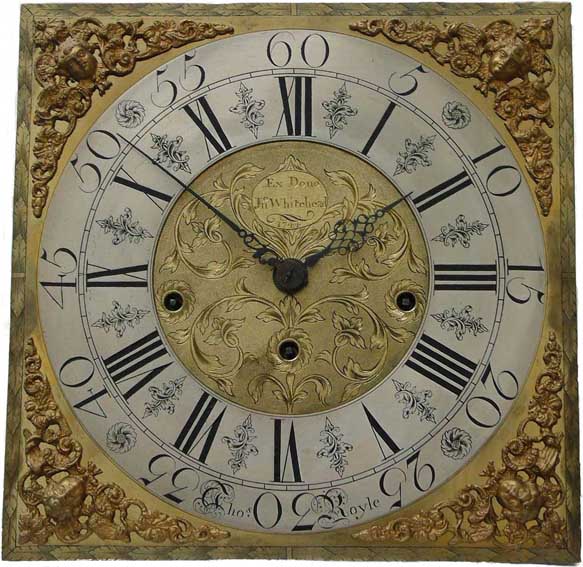 | ||||
|
Heres is Thomas Royles Sig. 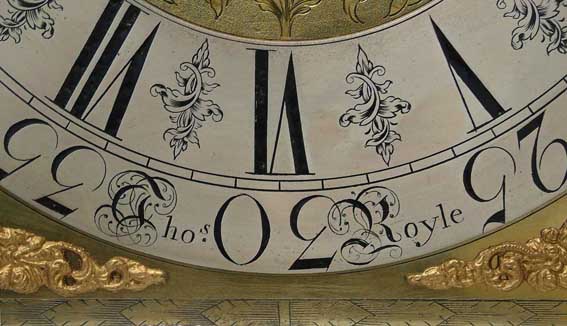 | ||||
|
Here in Latin The Gift Of John Whitehead 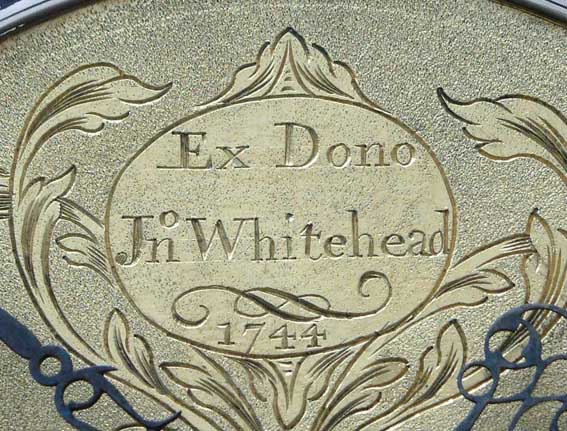 | ||||
|
Here is massive iron movement on three bells  | ||||
|
Movement shown from rear, showing massive iron plates to allow for the three trains 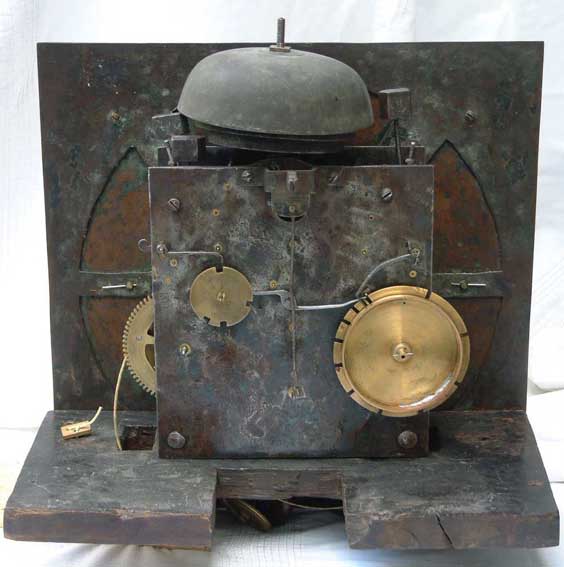 | ||||
|
Here is last picture showing exceptionally handsome dial of the Royle clock with original hands 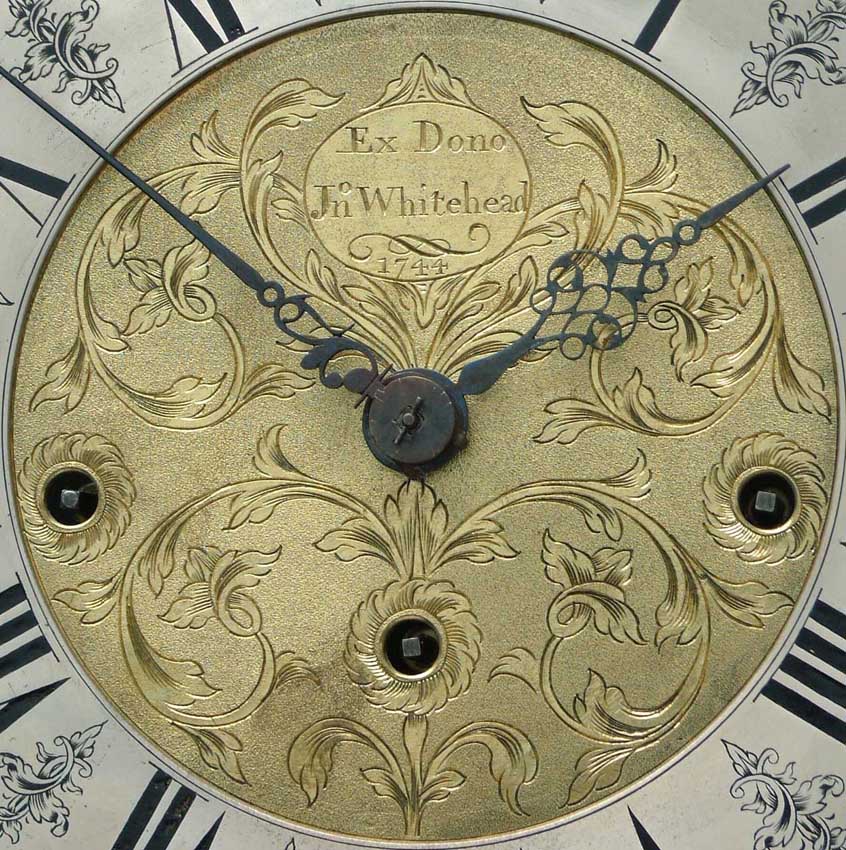 | ||||
|
| Powered by Social Strata | Page 1 2 |
| Your request is being processed... |
|
©2002-2025 Internet Horology Club 185™ - Lindell V. Riddle President - All Rights Reserved Worldwide

